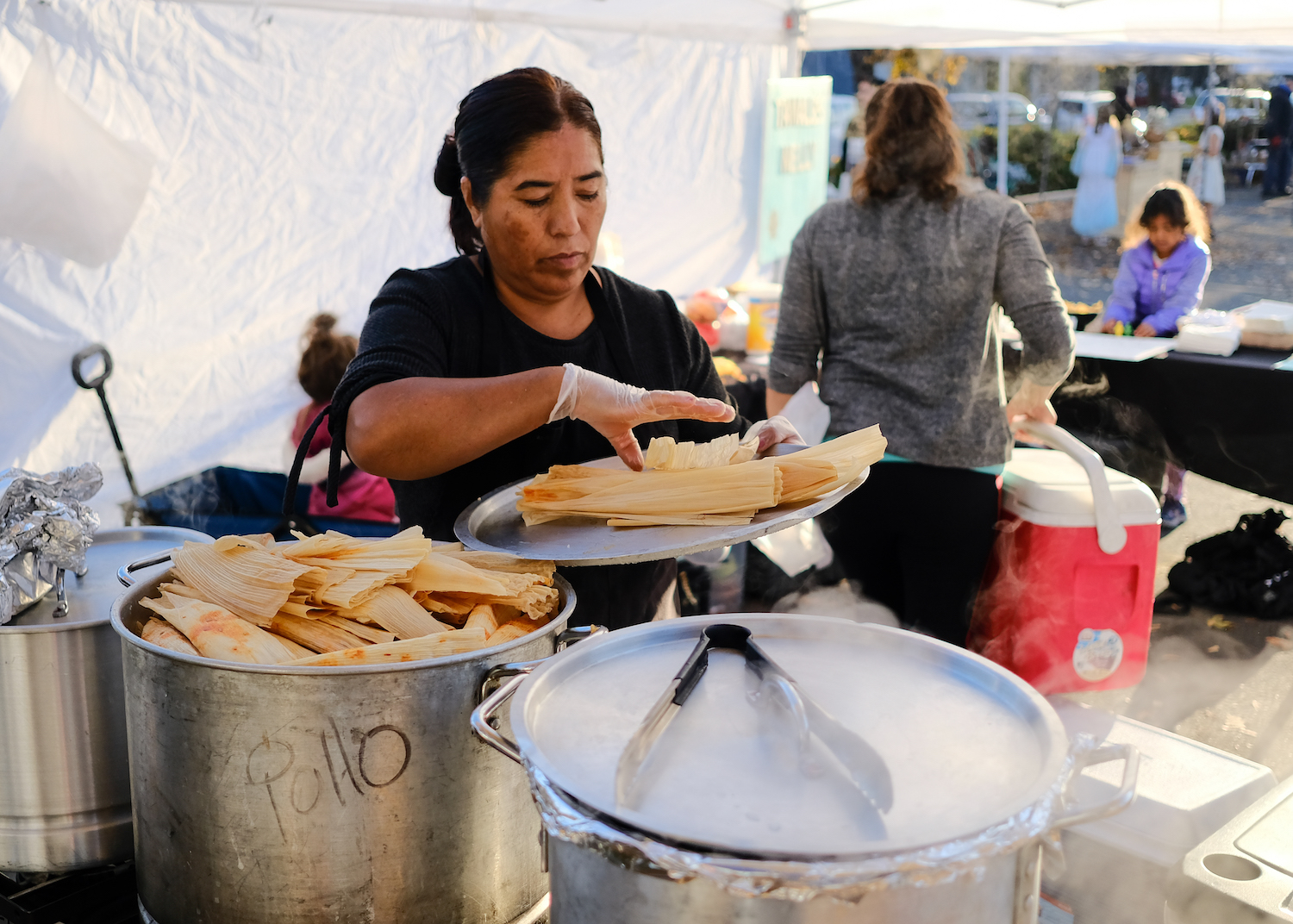Tamale Tradition
Isabel Arichega piles masa into an industrialsized roasting pan along with a dash of baking powder, a pour of liquid pork fat and a touch more masa. Her hands are the measuring cups, her eyes the teaspoons as her senses guide her toward the unwritten recipe handed down through generations and thousands of years of culinary evolution. She adds a little more pork fat and more masa, piling and pouring until the consistency of the dough matches what she remembers from her childhood in Mexico.
Three hours later, the off-white, nearly yellow mixture swaddles tender chunks of meat and freshly julienned vegetables—all nestled between softened husks of corn. This is only the beginning: She has a dedicated flock of tamale addicts to feed and with the winter holidays around the corner, Arichega and the kitchen staff at Taqueria El Torito start to rev up production.
“People know it is good,” Taqueria El Torito owner Modesto Arichega says of his wife’s ancient, addictive, homespun tamale recipe.
The Nayarit, Mexico, transplants built a new life and planted Idaho roots around her tamales in 1995. The Arichegas started small, selling to a budding clientele, and in 2002 built a brick-and-mortar market on Chinden Boulevard in Garden City. As their roots spread and the clientele grew, they moved forward, upgrading their storefronts along the way.
“When we started our business in 2002, all the people followed me to Garden City. And when we moved over here, all the people followed,” Modesto says from the kitchen of Taqueria El Torito’s newest headquarters on Boise’s State Street.
If you relate to the meme “Forget about pumpkin spice, it is tamale season,” the smell of steamed masa and chile-spiked meats signals a shift in weather and time for a seasonal comfort food fix. The tamale is one of the oldest portable comfort foods from the Americas and one of the few ancient culinary staples to survive the rise and fall of civilizations, colonialism and manifest destiny to become a mainstream, albeit sometimes underground, culinary mainstay. For many people it still tastes like that favorite memory of a trip to Latin America or evokes a welcome indulgence of warm, savory and sweet treats during the Christmas holidays.
For cooks like Karina Martinez, the tamale is more than comfort food; it brings family together and funds essential needs. Martinez and her family launched Tamales Nelly for her 6-year-old nephew Sebastian who suffers from Dandy–Walker syndrome, a congenital brain malformation. When Sebastian’s parents struggled to make ends meets with the added expenses of raising a child with a disability, the Martinez family started hawking tamales.
Their children’s teachers and caregivers were some of the first to offer donations in exchange for the treats. The extra cash helped but Sebastian’s care required a more substantial, regular income boost. Martinez got that boost after she took small business classes, found an industrial kitchen, applied for licenses and turned the family tamale trade into a full commercial operation. The family took positions on the assembly line between regular jobs and now the group effort raises more than $2,000 a month for Sebastian’s care.
From a shared commercial kitchen on Chinden Boulevard, three generations of Martinezes, including a grandma, aunts, cousins and grandkids, assemble in a line to crank out nearly 1,500 tamales that will make their way to weekend markets across the Treasure Valley. One aunt presses the masa into softened corn husks, another fills nature’s wrappers with a secret blend of meat, onions and spices while the rest of the brood rolls and preps the tamales for steaming. Hours of production starts before dawn on a Friday morning and ends sometime in the afternoons yielding a mild symphony of northern Mexican spice and chile that melds with tender meat encased in a dense, moist, finely ground maize dough.
It tastes a bit like the tamales you’d find along Texas borderlands, Martinez says. “Even the regions are different,” she says of the tamale variations that spill from various states of Mexico.
And if you’ve traveled to California, Texas, Mississippi, Chicago or other places around the United States where tamales show up on menus, you know how striking the variations can be in this country. If your travels took you farther south beyond Mexico and you found a purveyor of Central or South American tamales, you’ve noted the striking differences between a Mexican tamale and those from other countries. Colombians, for instance, serve “bollos” that are generally round or cylindrical, made from corn, yuca or potatoes and can be wrapped in banana leaves.
“The flavor of the meat is different; the temperature is different—ours is very moist but others will cook them more medium-rare. And the texture is different. There are even different spices in regions that you can’t get anywhere else. You have to work with what you have,” Martinez says.
Her mother, Juana, and her mother before her evolved a recipe that grew from the availability of spices and ingredients from Juana’s hometown in Zacatecas, Mexico. Martinez suspects the recipe evolved even more when the family moved to Monterrey, Mexico, before immigrating to the United States.
“In Mexico, the tradition is that you don’t have a recipe book. And you don’t have measurements. She [Juana] makes the tamales with a pinch here, a handful of this and a handful of that, so you really don’t know the measurements,” Martinez says.
“This is a family tradition. This is what my mom would make for the holiday. She would get up early and we would wake up to the smell of tamales. And we knew right away we would have to get up and help. She’d be, like, ‘Time to come help me stuff the tamales,’” Martinez remembers. And the smell of steaming meat and masa signaled a homecoming.
“We knew family was coming over. Our aunts would come over, our cousins would come over and we would eat a big plate of tamales,” Martinez says. “For us, it’s a tradition to serve them at parties. They come from the Aztecs and it’s a simple way to feed your whole tribe. It was more manageable than doing a tortilla and something else.”
Each tamale tells the story of ancestors, immigration, carving out new lives in one locale and then the next. The meat and maize filled husks or leaves that became an Aztec (and Incan and Mayan) staple feed families, workers and others who appreciate the heartiness and taste of a portable meal that provides all essential food groups.
Tamale prep with the Martinez family looks a little different than in the days when the smell of steaming tamales filled Karina’s childhood home. The masa that once bound generations now fills in gaps in family finances and helps newcomers gain economic footing but much of the intent behind the tamale remains the same. Tamales often pad incomes with weekly delivery at local offices, fill wage gaps from under-the-radar home kitchens and supply an underground economy with a commodity newcomers and traditional cooks use to gain financial footing.
One Boise Bench resident recently exchanged tamales for donations to fund a longoverdue trip abroad. Neighbors in another Boise-area neighborhood help an Idaho newcomer pay rent by buying weekly deliveries of tamales by the dozen. Neighbors help neighbors with distribution in some of the area’s underground sites and quietly ask that customers stay mum about the tamales that sometimes get cooked alongside a family dinner.
“It’s a long process but you can feed hundreds of people,” Martinez says.







